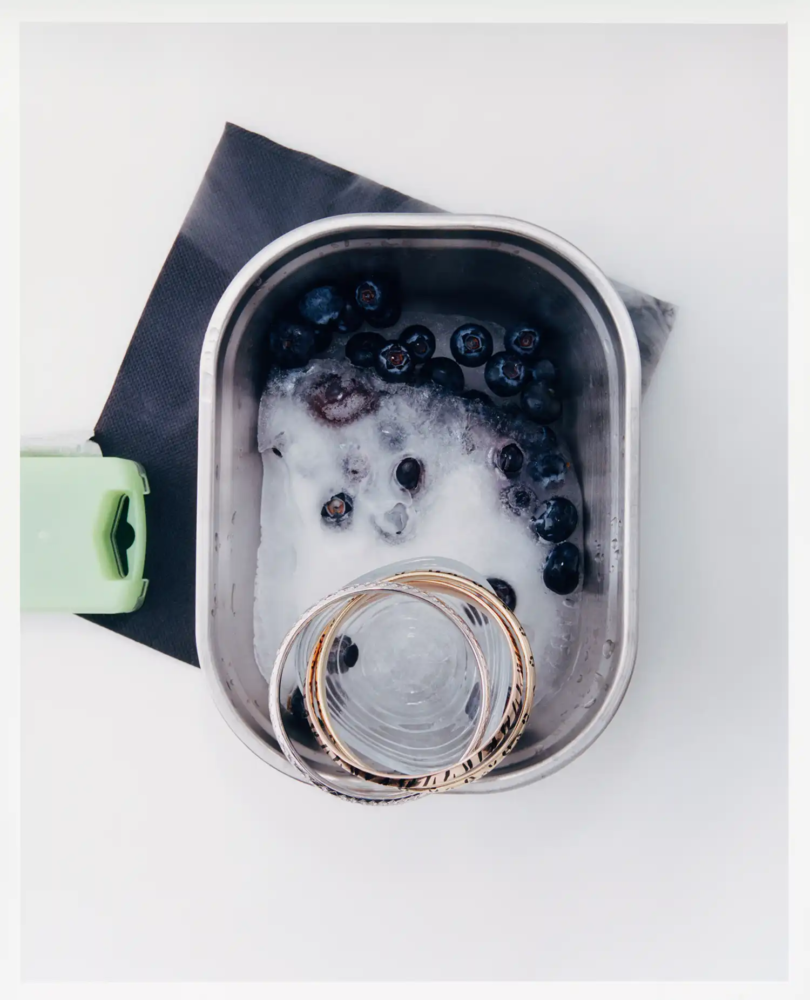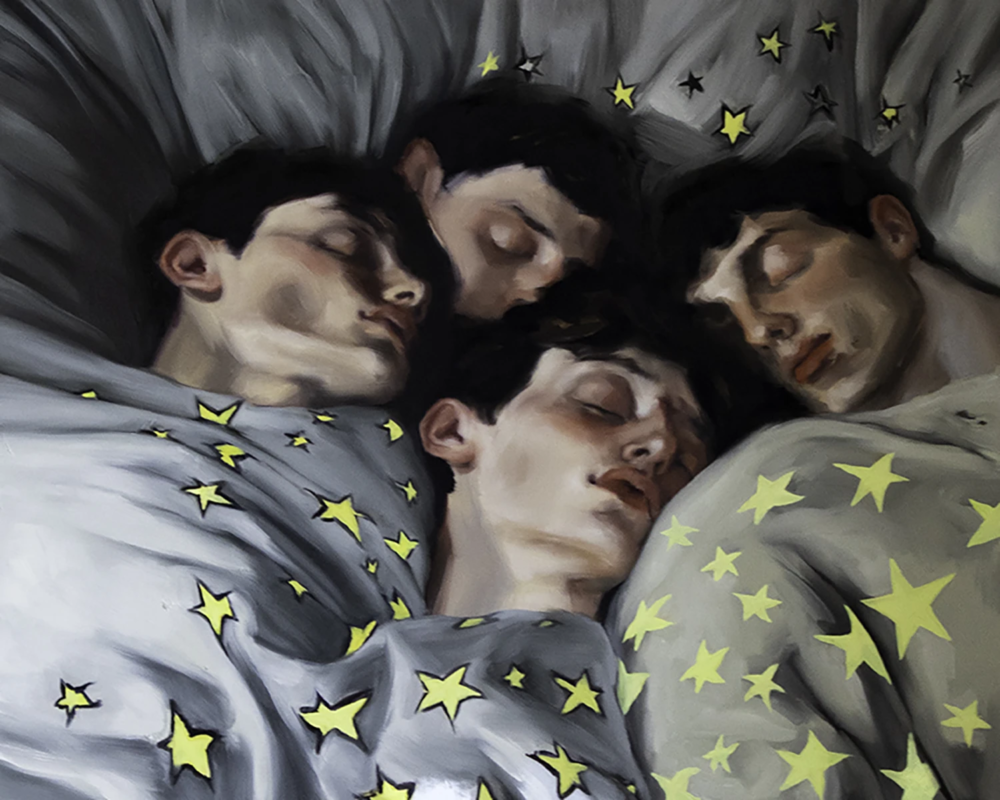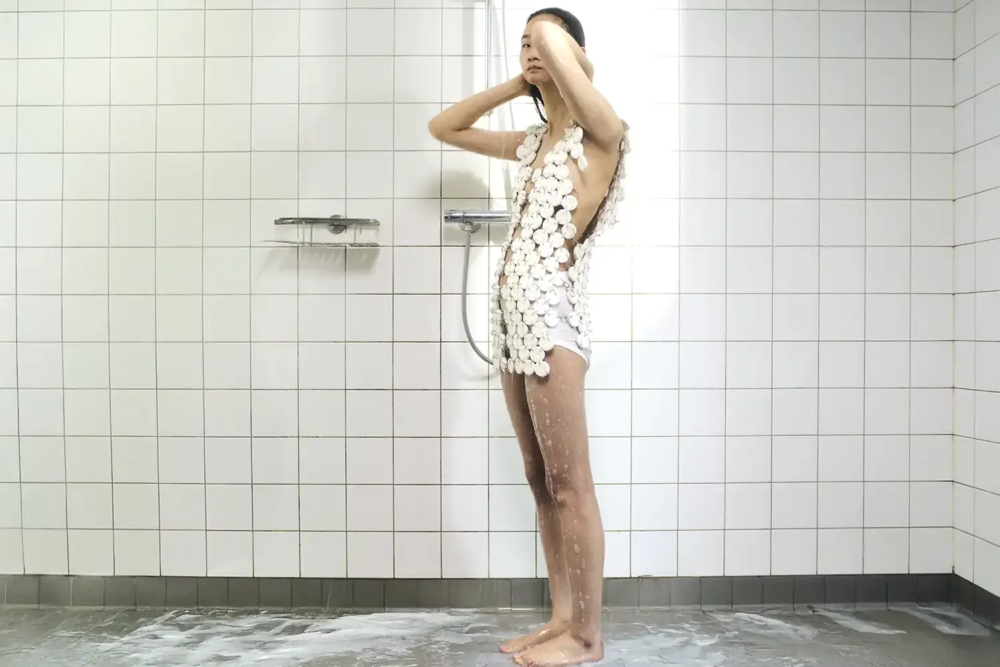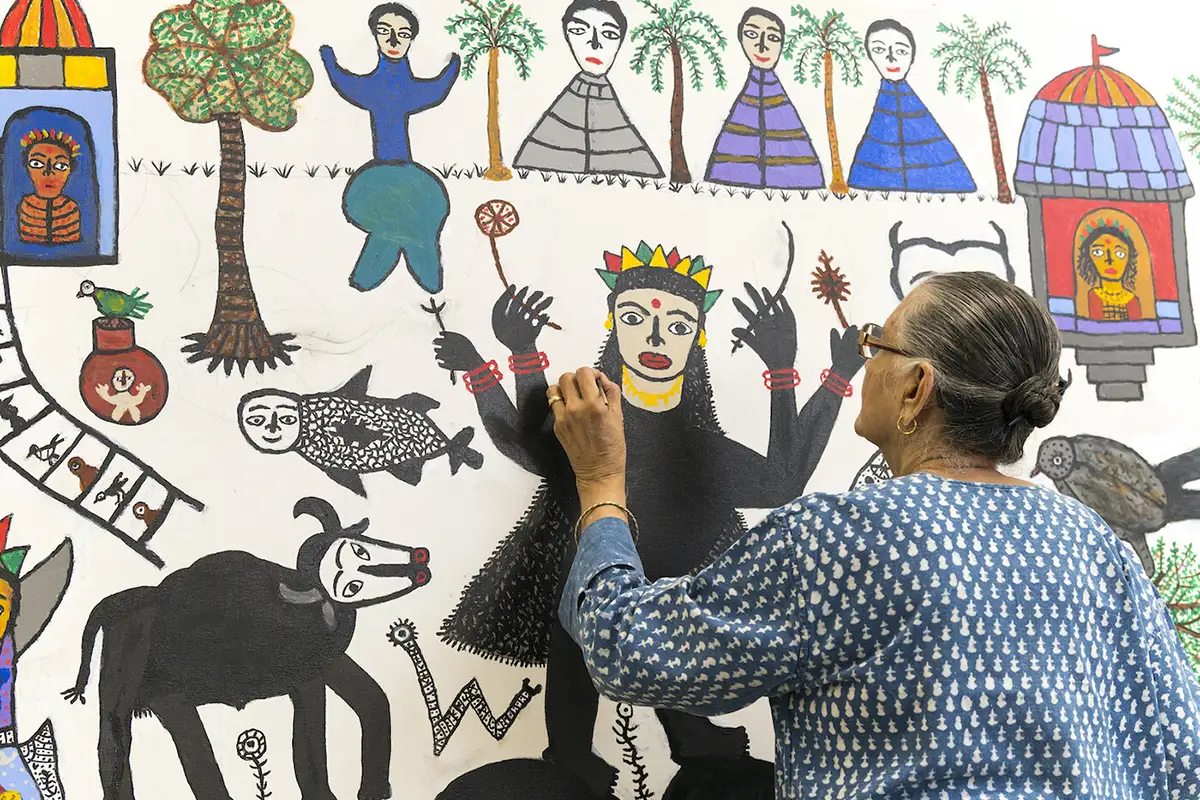
Cosmic Garden: safeguarding Indian craft manufacturing
The Cosmic Garden exhibition at the Venice Biennale is committed to the emancipation of women through craftsmanship – with the support of Dior. A dialogue with Karishma Swali, from the Chanakya School of Craft
Foreigners Everywhere – (meaning Stranieri Ovunque, ed). Indian craft manufacturing at the 60th Biennale d’Arte di Venezia
«The seeds of this collaboration were sown many years ago when I began collecting the works of Manu Parekh and Madhvi Parekh. What followed were a series of conversations centered on our mutual passion for craft and the rich artisanal legacies of our country. The title Cosmic Garden originates from a key work observed during our collaborative discussions in Manu Parekh and Madhvi Parekh’s studio. One of Manu’s paintings titled The Gate of the Cosmic Garden symbolizes a gate opening into a garden, facilitating an exchange of energies.
This perfectly aligns with the core vision of our exhibition, which is celebrating the pluralistic beauty of a coming together of various disciplines. The term ‘Cosmic’ denotes the karmic and the spiritual. This resonates with the value system of the Chanakya Foundation and that of the artist’s practice over the last six decades. Additionally, it encapsulates the principle of submission, which serves as an ethos guiding our work across disciplines. Bringing this practice to life, the exhibit features paintings and sculptures by Madhvi Parekh and Manu Parekh and an exploration of a new interdisciplinary medium: hand-embroidery.
This evolution is presented through crafted works and sculptures created by the artisans of the Chanakya School of Craft. Presenting ‘Cosmic Garden’ as a Collateral Event of the 60th La Biennale di Venezia is marking a pivotal moment to showcase Asian cultural heritage on a global stage. Through this exhibition, our endeavor is threefold: to blur assumed hierarchies within fine art by introducing a new language through an interdisciplinary collective approach, to recognise highlighting communities in representing their material culture, and to present an aligned vision for preserving India’s cultural heritage and artisanal legacies.
So far, India’s presence at the Biennale has been limited, and we are so proud to celebrate our artistic collaboration with Manu and Madhvi, offering a unique perspective rooted in culture and contemporary expression».
Madhvi Parkeh and Manu Parekh: a collaborative approach and craft manufacturing – unveiled at the Dior Spring Summer 2022 haute couture presentation
Madhvi Parekh’s paintings revolve around her childhood memories, Indian mythology, women’s craft, art and folk legends, like Snake in the Sea, from 1975. Manu Parekh’s works are instead characterized by broken lines, stripes, crosses and floral motifs, with a fascination for Paul Klee and Rabindranath Tagore, as seen in Chanting in Moonlight, the painting from 2022. The artist was influenced by Modernism through the teachings of S.B Palsikar at the J.J. School of Art. Both artists embody the cosmic harmony of masculine and feminine energies, in life, as they are a couple, and in their works – thus populating the Cosmic garden of new possibilities, where the viewer is invited to participate.
Through an intuitive use of color and the use of bold lines, the artists extend their imagination not only to the influences of Nature but also to the nuances of daily life and social issues, underlining the iniquities many marginalized categories still have to face in society. The interdisciplinary works created by Karishma Swali and the Chanakya School of Craft, some of which in collaboration with Madhi and Manu Parekh, like Resting Near the Pond, from 2023, made of organic jute, cotton, linen and raw silk thread on cotton textile, transcend conventional and preconceptions boundaries to carve out a new artistic languages starting from those firmly rooted in India’s collective cultural histories made of pluralities.
First unveiled at the Dior Spring Summer 2022 haute couture presentation – the works are brought to life through needlework embroidery and handcraft techniques, preferring organic materials like raw linen, jute, silk, and cotton. Affirming a practice that redefines the roles of both artist and artisan, blurring the boundaries between art and crafts.
Venice Biennale 2024 – Madhvi Parekh and Manu Parekh
«Working with Madhvi Parekh and Manu Parekh, a married couple with 65 years of partnership, has been an enriching experience. Their collaborative and communal approach to art allows for a sense of freedom and collective creativity. They value individual voices and encourage contributions from everyone involved, fostering a true artistic collaboration. Madhvi Parekh’s artwork, rooted in her village life and rich with fantasy, translates onto canvas. To interpret her work, a primitivist expression was adopted, using dimensional techniques in repetition to create background textures that evoke a magical world of folktales and pastoral scenes populated by village deities, forests, animals, children, and amorphous forms.
Additionally, techniques such as coughing and fine-needle zardozi stitches were used to achieve a sfumato effect, allowing tones and colors to blend gradually, creating softened outlines and hazy forms. Manu Parekh’s modern abstractions, influenced by Indian vernacular and spirituality, presented a different yet equally captivating challenge. His ‘Chant’ series, which translates sound energy into visual form, inspired us to explore the vibrancy of chants through thread. We utilized traditional Indian embroidery techniques alongside contemporary design principles to create pieces that capture the dynamic energy and cultural depth of his paintings».
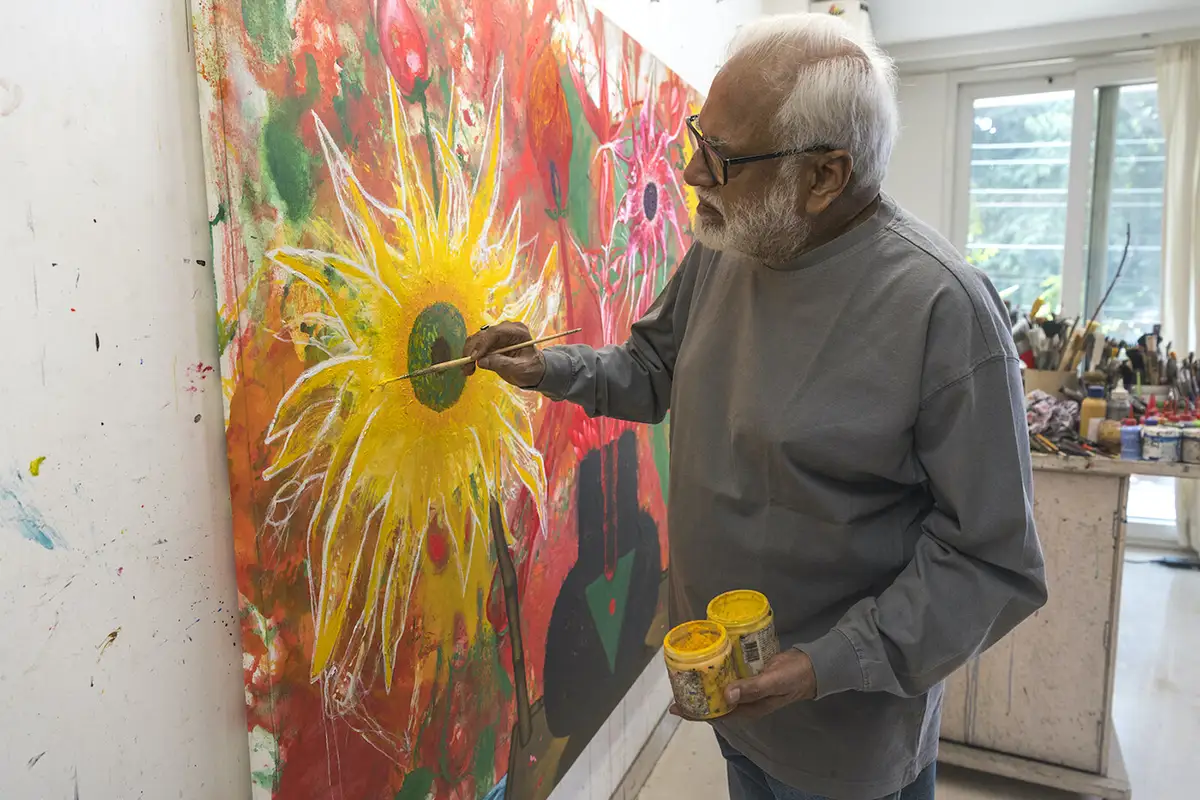
The Chanakya School of Craft: cultural sustainability, responsible innovation, craft excellence, organic processes in collaboration with Dior
Over her 25-year career, Karishma Swali has dedicated herself to the preservation of India’s cultural heritage of craft’s excellence. Under the guidance of Maria Grazia Chiuri, Creative Director of Dior women’s collection, Chanakya Foundation’s co-founder, Karishma Swali, established the Chanakya School of Craft in 2016 as an institution to help women harness the power of craft and to address the pressing challenges they find in society. The school’s guiding mission is twofold: safeguard India’s cultural heritage and unlock the infinite potential of craft. To-date, the school has taught over 1000 women, across all ages and socio-economic backgrounds, forming a strong community of skilled women.
«School is the most humbling aspect of my professional career. Established in 2016, Chanakya School of Craft is a non-profit school and foundation dedicated to craft, culture and creating new autonomy for women. Our aim was to create a nurturing environment where women from diverse backgrounds could harness their creativity and skills to address pressing socio-economic and environmental challenges. Inspired by Rabindranath Tagore’s holistic philosophies, our school promotes experiential learning and active engagement with cultural heritage.
Our mission is to foster an inclusive and knowledge-driven environment for women, equipping them with the skills needed to thrive independently in the world. The school has taught over 1000 women to date, across all ages and socio-economic backgrounds, forming a strong community of skilled, autonomous women. The goal for the school is to create a platform of multi-dimensional learning focused on the arts and crafts while providing equal opportunity to an often-ignored backbone of our communities: women. Inspired by India’s innate nature of non-violence and universal compassion, the philosophy at Chanakya School of Craft is to integrate care and consciousness into everything. Sustainable development means to fulfill the present needs without compromising the needs of future generations.
Cultural sustainability is at the core of everything we do – craft manufacturing
The process of hand embroidery for generations has been one that is free of violence, pollution, and carbon footprint and is one that catalyzes internal harmonies. Sustainable fashion concerns more than addressing fashion textiles or products. It comprises addressing the whole system of fashion. Cultural sustainability is at the core of everything we do — acknowledging that culture is embedded in craft, working towards preserving it and transferring this knowledge to keep it alive for future generations. This means dealing with interdependent social, cultural, ecological systems. It also means considering fashion from the perspective of many stakeholders, users and producers, all living species, and contemporary and future generations of our planet».
Craft manufacturing, tradition and innovation: textiles and the concept of sustainability
The school offers a platform of multi-dimensional learning, focused on the arts and crafts while providing equal opportunity to an often-ignored backbone of our communities: women. The curriculum teaches over 300 hand embroidery techniques through a holistic curriculum anchored through the voices and lives of historical female figures. The textiles mostly utilized are organic materials like raw linen, jute, silk, and cotton to capture the purity of the artists’ and Karishma Swali’s aligned vision.
«At the Chanakya School of Craft, tradition and innovation converge seamlessly in our textile work. These traditional materials serve as the foundation upon which we build our innovative approaches and designs, integrating modern techniques and styles while preserving the essence of our cultural legacy. Our curriculum encompasses a rich array of textile techniques, each with its own historical and cultural significance. From the intricate Kantha Embroidery of West Bengal and Bangladesh to the delicate Chikankari of Lucknow, our students immerse themselves in diverse forms of craftsmanship.
Cosmic Garden and cultural sustainability: craft manufacturing
Vibrant Phulkari from Punjab, luxurious Zardozi originating from Persia but popularized in India, and the traditional tie-dye art of Bandhani practiced in Rajasthan and Gujarat all find a place in our teachings. We delve into the intricate hand-painted motifs of Kalamkari from Andhra Pradesh and Telangana, the rich silk weaving of Kanjivaram from Tamil Nadu, and the fine Pashmina weaving of Kashmir. Our students also learn the intricate Banarasi Brocade weaving of Varanasi and Madhubani Painting from Bihar.
Through these techniques, we preserve these rich cultural traditions while fostering creativity and entrepreneurship among our students. Sustainability is a core principle that guides our practice. Our approach to sustainability is two-fold. The first is ecological, which means circularity is intrinsic to everything we do at school. We use only organic dyeing processes like vegetable dyeing processes and limit it to necessary quantities. We use organic cotton, hemp or linen and forest stewardship textiles. All of Cosmic Garden is created with only organic fibers. The second is cultural sustainability, which is acknowledging that our culture is embedded in craft and preserving it is for the future generations. Both these aspects of sustainability are integral to the foundation».
Arts and craft manufacturing and community building in India – artistic collaboration with Dior, Maria Grazia Chiuri, Manu Parekh and Madhvi Parekh
Traditionally, handcraft skills in India are passed from fathers to sons. But the schools’ teaching of the art of hand embroidery and the color theory exposes the female students to various facets of culture and design, opening to new outcomes, to foster an inclusive and knowledge-driven environment for women, equipping them with the skills needed to thrive independently in the world.
«In contemporary Indian art, the relationship between arts and crafts, as well as between artists and artisans, is symbiotic and dynamic. Arts and crafts coexist harmoniously, with each influencing and enriching the other. Artists often draw inspiration from traditional craft techniques, incorporating them into their creative process to produce unique and innovative works of art. Similarly, artisans infuse their craftsmanship with artistic elements, elevating traditional crafts to new levels of artistic expression. This collaboration blurs the lines between art and craft, highlighting the interconnectedness of creativity and skill. Our artisans are the custodians of India’s cultural heritage. It is their skill and generational knowledge that keeps the age-old tradition of craft alive even today.
Our artistic collaboration with Dior, Maria Grazia Chiuri, Manu Parekh and Madhvi Parekh is an example of their inherent skill and talent. Training women in color theory, semiotics and art history, in a simple and engaging manner, helps the students embrace craft in all its aspects. Students are also taught skills useful for a professional environment such as the English language, craft history and finance management skills. Finally, to give students a holistic view, we coordinate visits to museums, workshops and other places. Our emphasis on community building through craftsmanship serves as a catalyst for inclusivity, enabling women – the backbone of society to find belonging and assert their creative agency in the world of art and design».
The collaboration with Dior’s creative director Maria Grazia Chiuri: freedom through expression, independence, knowledge and empowerment
With support from Maria Grazia Chiuri, Creative Director of Dior women’s collections, the non-profit institute was dedicated to craft, culture and creating a new autonomy for women. The foundation’s vision is focused on fostering cultural sustainability and holistic advancement through education, skill development, and dedicated efforts to safeguard India’s rich artisanal heritage and promote the arts.
The foundation’s mission is to empower women from underserved communities through exceptional education in hand craftsmanship, enabling them to unlock their full potential and elevate their quality of life. By instilling a visionary perspective, cultivating role models, and fostering a strong sense of community, the Foundation is dedicated to the transformation of societies.
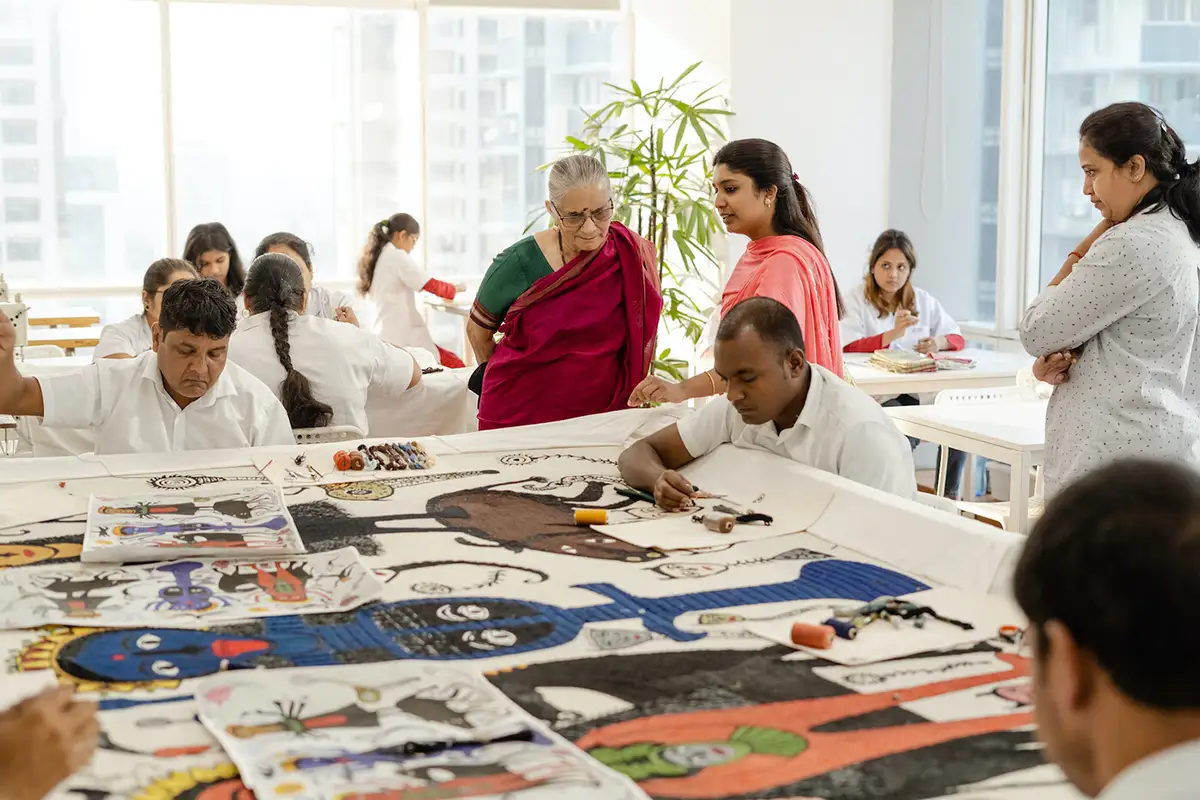
Maria Grazia Chiuri: each Dior show is the opportunity to forge captivating artistic collaborations
«For Maria Grazia Chiuri, each Dior show is the opportunity to forge captivating artistic collaborations – the Chanakya School of Craft has thus become a key partner in the conception of artworks and installations that have sublimated a number of Dior défilés. I met Maria Grazia nearly 25 years ago and discovered our common love for excellence in hand craftsmanship. Maria Grazia’s commitment to celebrating artists and artisans worldwide, championing culture, craft, community, equality, and justice has had a profound influence on me. We began exploring innovative ways to preserve artisanal legacies together.
Through these collaborations we want to amplify global craft communities and advocate for women to find a shared space to express themselves freely and creatively. At its core, this collaboration symbolizes the transformative power of art and fashion in challenging norms and fostering inclusivity. It’s a testament to the potential for creativity to drive social change and enable individuals to embrace their authentic selves».
The future of the Chanakya School and School of Craft, Mumbai
«We expand our projects, collaborating with artists, fashion brands, and nonprofits to promote inclusivity and hand craftsmanship. Our future vision involves establishing a global network where design students can seamlessly integrate craft into art and design. Additionally, our commitment to fostering cultural exchange and innovation is evident through our Culture Centre and The Living Museum. These spaces serve as hubs for global cultural exchange through artist collaborations. We are investing in research, community engagement, and collaborative initiatives to propel mutual holistic growth and contribute to the advancement of culture and society towards a more interconnected and harmonious world».
About Chanakya Foundation and Chanakya School of Craft with Dior support
Recognising a compelling need to institutionalize craft and implement holistic solutions for socio-economic and environmental issues, the Chanakya Foundation and School of Craft were founded in 2016. With support from Maria Grazia Chiuri, Creative Director of Dior women’s collections, the non-profit institute was dedicated to craft, culture and creating a new autonomy for women.
The foundation’s vision is focused on fostering cultural sustainability and holistic advancement through education, skill development and dedicated efforts to safeguard India’s rich artisanal heritage and promote the arts. The school has taught over 1000 women to-date, across all ages and socio-economic backgrounds forming a strong community of skilled, autonomous women.
Cosmic Garden: presenting South-asian craft manufacturing on a global stage
Curated by Maria Alicata and Paola Ugolini and held at Salone Verde – Art & Social Club, on view from Saturday, April 20th to Sunday, November 24th 2024, Cosmic Garden is a collateral event of the 60th Biennale d’Arte di Venezia – Foreigners Everywhere.The exhibition is an ongoing exchange between Indian artists Madhvi Parekh, Manu Parekh the Chanakya School of Craft and Karishma Swali, to celebrates women’s transformative energy with paintings, sculptures and hand-embroidery works.
The project aims to dismantle hierarchies between the arts, roles, and gender, transcending the confines of domesticity by bringing embroidery into the public sphere. We spoke to Creative Director Karishma Swali about the upcoming exhibition as a collateral event of the 60th Biennale d’Arte di Venezia, Foreigners Everywhere – Stranieri Ovunque, curated by Adriano Pedrosa.

